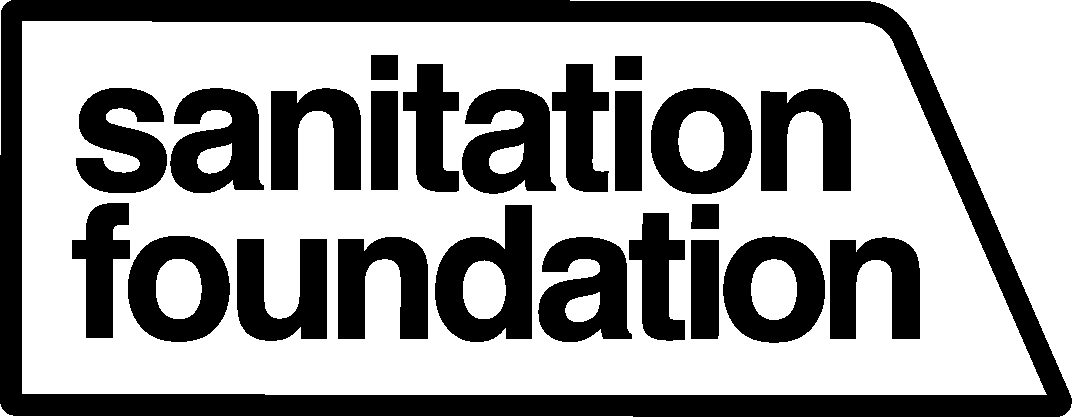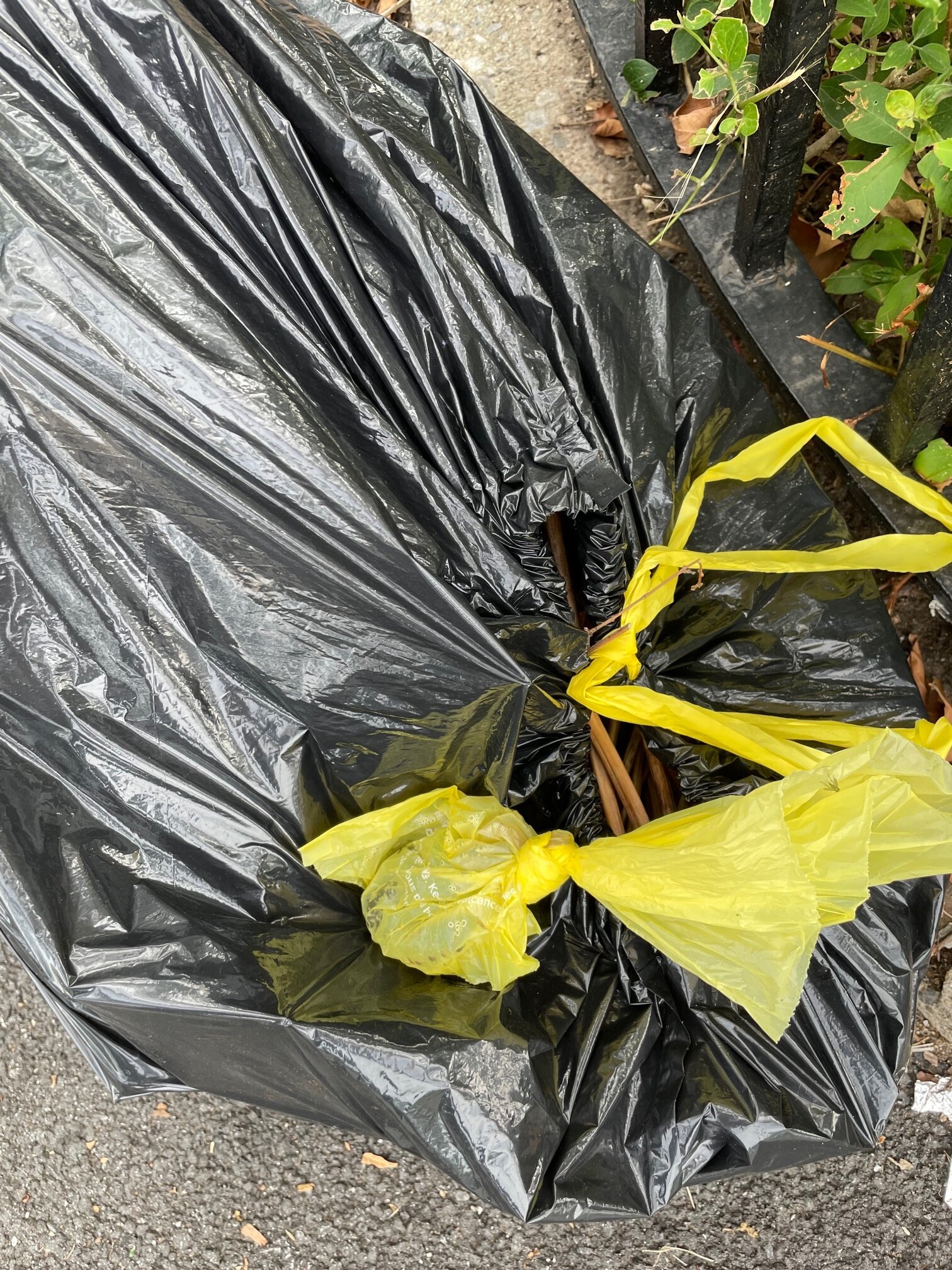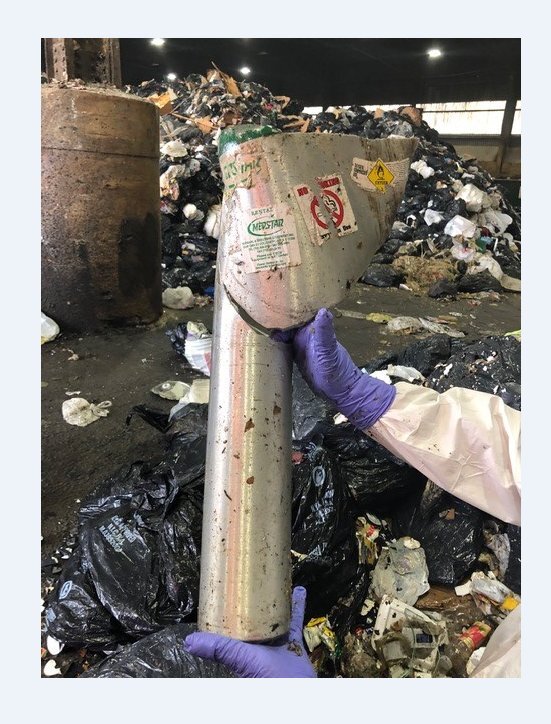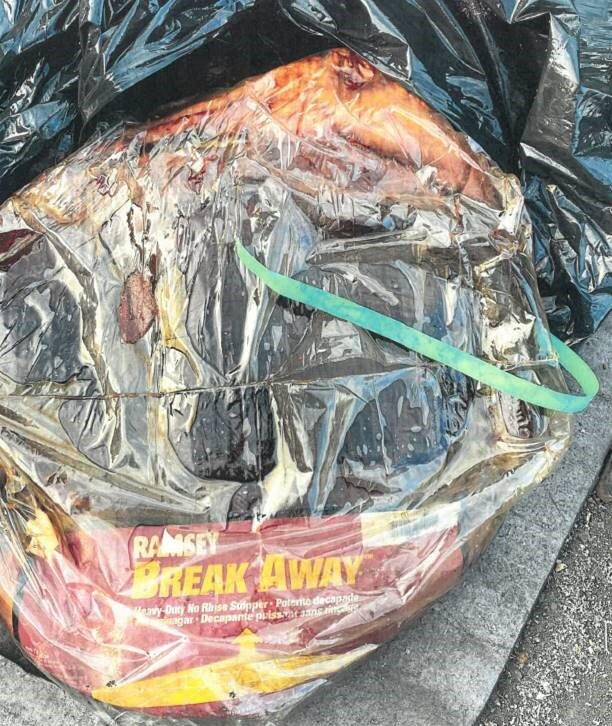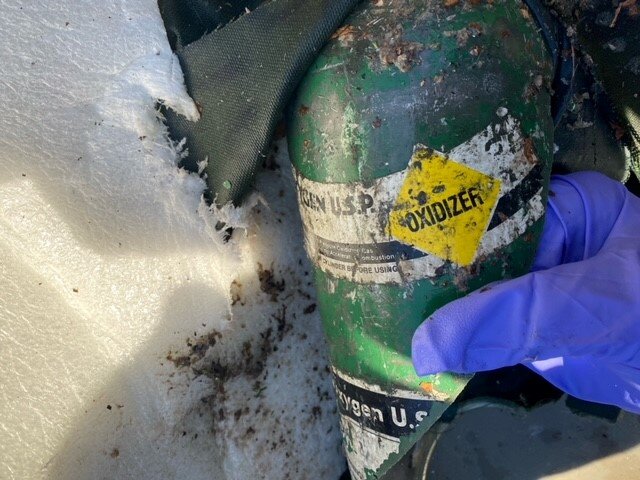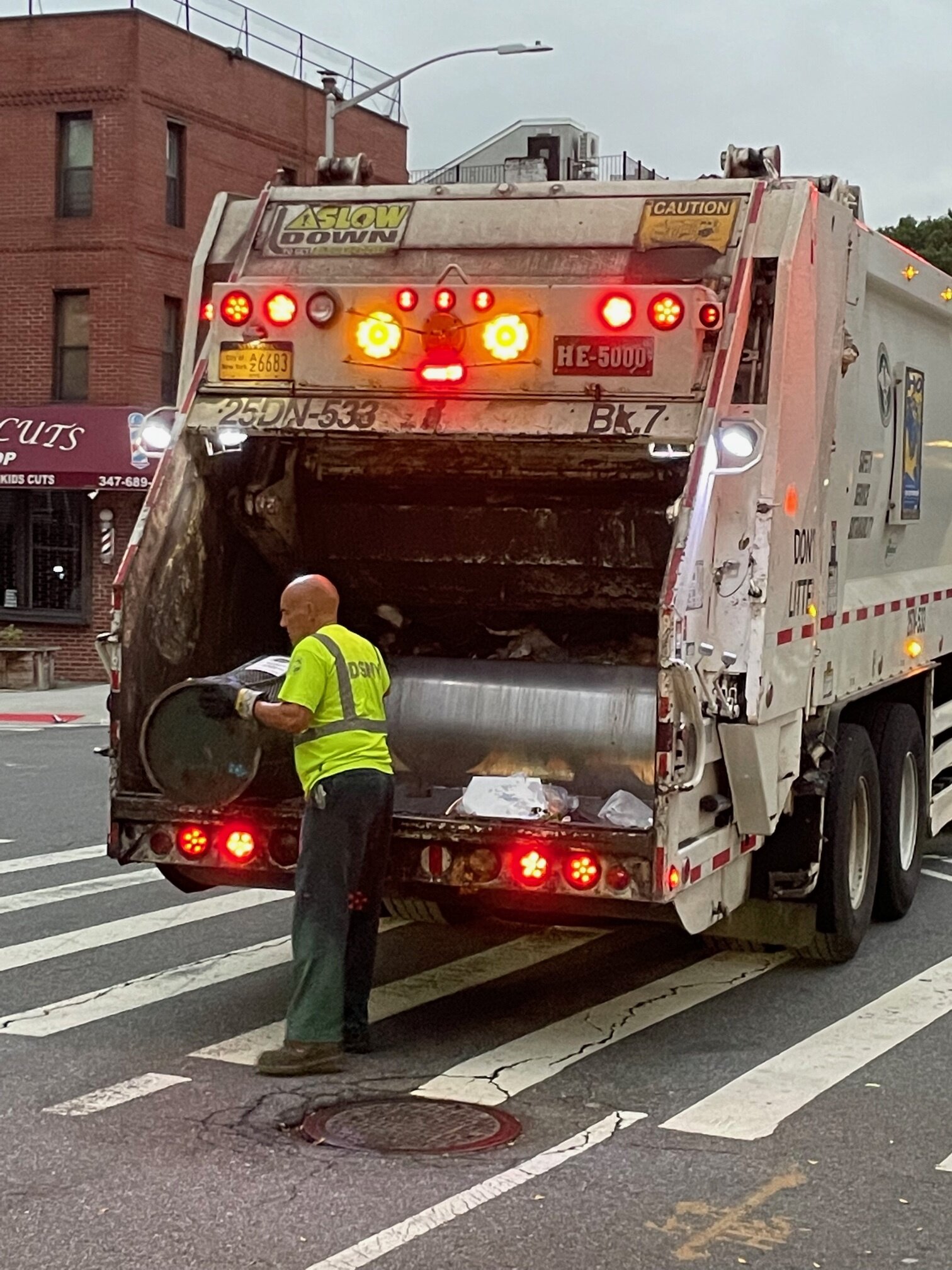Careful Waste Disposal Is An Act of Community Care
By Jeanne Lurvey & Jesi Cruz
Sharp objects, toxic substances, and combustible aerosol cans. These are but some of the many dangerous items that end up in the trash every day and that pose serious risks to our hardworking Sanitation Workers. Jeanne Lurvey and Jesi Cruz explore the broader community impacts of what it means to be negligent about proper waste disposal practices.
Sanitation Workers are vital members of our community, whose labor and care on the job make it possible for New York City to function.
Their work stands at the intersection of public health, public safety, and sustainability.
Unfortunately, the job of trash collection isn’t portrayed as such in popular media and culture—if it’s even portrayed at all—and as a result, the complexities of waste management and the sometimes harsh realities of what it’s like to work in the field are invisible to the vast majority of people.
Moreover, collecting waste is a physically demanding and dangerous profession. In New York City, moving waste from sidewalks to the truck requires manual labor. Heavy bags and bins are carried by workers to the back of the Sanitation truck to be compacted and transported. Due to the tough physical nature of the job, Sanitation Workers often suffer pulled muscles and torn ligaments, the result of constant lifting and carrying waste from curb to truck.
Trash collection can be dangerous work!
In addition to the physical impact of heavy lifting, the job of the Sanitation Worker becomes even more dangerous when New Yorkers fail to dispose of their trash properly. Serious injuries occur while collecting household waste from hazardous, toxic, or sharp objects being improperly disposed of at the curb. Dangerous substances or materials are invisible to the eye due to the opacity of black trash bags and garbage bins.
From exploding hair spray cans to toxic chemicals to jagged glass, and countless other hazards that poke through incorrectly labeled bags and improperly stored materials, Sanitation Workers are—sometimes fatally— exposed to numerousthreats to their safety.
A broken oxygen tank becomes a massive metal shard that can make deep cuts.
One common cause of injury is when bags of household waste contain broken glass, ripping through the plastic bag, resulting in sharp cuts to workers’ lower legs.On one occasion, a New York City Sanitation Worker slung a trash bag hiding a half inch thick broken glass tabletop which sliced his upper thigh. This caused a severe gouge and put the worker into shock! The injury could have been fatal. However, with a stroke of luck, a telecommunications truck, coincidentally driven by a former Army medic with first aid supplies, stopped to help, applied a tourniquet to the leg, and saved the man. Sixty stitches were needed, inside and out.
In 1996, a severe incident occurred, taking the life of a sanitation worker named Michael Hanley—and injuring his co-worker who rushed to his aid. A container of hydrofluoric acid, a corrosive acid used to etch glass, was thrown in with residential waste. The container of acid exploded under the pressure of the hopper in the back of the sanitation truck, emitting potent fumes which Hanley inhaled, taking his life, and severely burning his co-worker Thomas Giammarino’s face and hands.
Do you know what you can and can’t throw away?
Other household items tossed into garbage bags can cause surprising injuries on collection routes. Pressurized cans of oxygen hidden in a black trash can be of great danger when placed in the sanitation truck’s hopper. The cans have exploded under the compaction, embedding a worker’s face with aluminum. Aerosol hairspray can also be a hazard due to the pressurized nature of the product’s packaging. A pressurized container burst under the weight of the truck’s metal plates and blades which hydraulically condense the trash. The compaction caused the liquid contents to spray out, burning the sanitation worker’s eyes placing him in the hospital.
Pictures, from top to bottom: An industrial chemical caused burns to a Sanitation Worker’s legs. Another oxygen tank poses threat of cut and explosion upon compression in a sanitation truck. E-waste is categorized as hazardous waste due to the presence of toxic materials such as mercury.
Again, these horrible and frightening incidents can be prevented. We have a duty and a responsibility to extend the values and principles of educated and intentional community care to sanitation workers—in the form of proper waste management.
This begins with educating ourselves about our city’s waste infrastructure, and learning how to properly dispose of our waste streams by checking out the learning resources that the Department of Sanitation has to offer! As you dive into the myriad learning resources provided by DSNY, you’ll discover the many different rules, regulations, and guidelines regarding the proper disposal of trash.
It’s also important to learn about the vehicles that enable sanitation workers to do their jobs by compressing and transport discarded materials.
Sanitation trucks are powerful pieces of machinery, not only for transporting huge amounts of waste, but also for compacting and crushing discarded items with a robust hydraulic system. For those on the job, the sounds of the levers on the truck and the metal blades compacting waste are cues on where to move or stand, when to toss trash into the back hopper, when to keep their bodies out of contact with any machinery or waste debris as bags are compacted. While citizens may grow annoyed at long lines of traffic while waiting behind collection, or the usually-avoided sight of trash collection, these trucks are to be revered.
Sanitation Workers are heroes. Let’s protect them.
In addition to the day-to-day collection of residential and municipal waste, DSNY collection workers are also responsible for huge city-cleaning tasks such as preparing the streets of NYC for inclement winter weather conditions and removing snow from the streets during and after winter storms. Sanitation employees also take on the heavy lifting of removing residential debris from hurricane damage and flooding from extreme precipitation. Unanticipated events such as the September 11, 2001 attack on the World Trade Center in downtown New York City also leaned on DSNY for cleaning the massive amounts of debris from the destruction of buildings and lives lost.
All of this disaster clean-up can also usher in various personal health hazards and risks for sanitation workers.
The most recent challenge to the safety of DSNY has been Covid-19, which threatened a high risk of exposure to workers interacting in close quarters with partners and handling waste. DSNY was not only short-staffed due to worker illnesses, but was collecting even more residential waste as people were predominantly at home due to the lockdown. Workers' lives were also lost to Covid-19. The risks sanitation workers face collecting waste, keeping city streets safe and clean, and removing disaster debris causes a ripple effect that impacts the personal and financial health of their families—and in the case of Covid, their entire communities.
All things considered, it’s worth taking the time to ensure that you’re disposing of your materials properly so that the conditions of possibility for Sanitation Workers’ injuries are drastically reduced. Placing items on the curb doesn’t mean trash items are out-of-sight, out-of-mind. They are handed off to another person.
As Charlie Eisenbach, a long-standing DSNY sanitation worker who serves on the Board of theSanitation Foundation wisely points out, there is no actual “away” when we throw something away. Disposed items have an entire second life in the waste management system, with many vulnerable, hardworking people involved. Eisenbach is working to create visibility for all Sanitation employees by sharing his experience collecting waste in NYC. His pride in DSNY is evident; be it the history of the department, manufacturing the parts to repair the trucks and continuing to manage the repair of the truck fleet today, elevating waste collection work while staying humble, or gratefulness for the strength of the DSNY labor union. Through elevating the stories of Sanitation Workers and the dangers they face, we can foster thoughtfulness that spurs behavioral change when placing waste at the curb, recognizing it has many miles to go with many lives impacted along the way.
So, get curious. Learn about how products behave when they’ve reached the end of their initial use phase, and enter their disposal phase inside the trash bag. Some tips for safe, conscious disposal include:
Wrap broken glass in bubble wrap or paper then place it in a cardboard box, tape shut and label “broken glass”
Remove exposed nails and screws from pieces of wood and furniture
Drop off used propane tanks to a SAFE Disposal Event held by the city, exchange used tanks when purchasing a new one, bring it to a hardware store for reuse or recycling, or drop tanks off at a scrap metal dealer for recycling
Special Waste drop off sites and SAFE Disposal Events provide places for residents to safely dispose of hazardous waste
Remembering the interconnectedness of community and the ripple effects of our actions when purchasing items and when reaching the end of our use for them is an essential part of caring for one another and the planet. Eliminating the habit of putting hazardous materials in opaque black trash bags and bins is an easy step to increasing the well-being of those keeping residents safe by removing trash.
Changing people’s psyche around waste is key to changing our footprints
We can all start to shift our behavior toward waste disposal by rethinking our relationship with convenience and consumption, advocating for educational campaigns, sharing our knowledge with our community, getting curious about the waste we generate, and finding or creating alternative ways to keep items in-use, recycled, or repurposed before sending them to landfill or incineration (which pollutes the air, the land, the water and the health of those living along waste transport routes and in the vicinity of incineration plants and landfills).
But while we strive to generate less waste, caring about the health and safety of those who manage and dispose of it for us is an essential community responsibility. Caring for Sanitation Workers is both a public safety duty and a public health duty. Any ignorance or carelessness in our personal waste disposal, even if due to lack of equitable access to educational resources, poses a threat to the wellbeing of sanitation workers, who, as we’ve established, are owed much more awareness and respect than has been traditionally granted to them. Their work makes all other work possible and without them our city wouldn’t be able to function safely. The first step toward caring is properly disposing of our trash. It’s the least we can do.
Jeanne Lurvey is a graduate student studying sustainability & environmental management with a focus on the role convenience and consumption play in waste, climate justice & social justice. Jesi Taylor Cruz is a graduate student with a focus on the impact of waste-based structural violence on marginalized communities; she sits on the BPI Composter and Municipality Committee.
